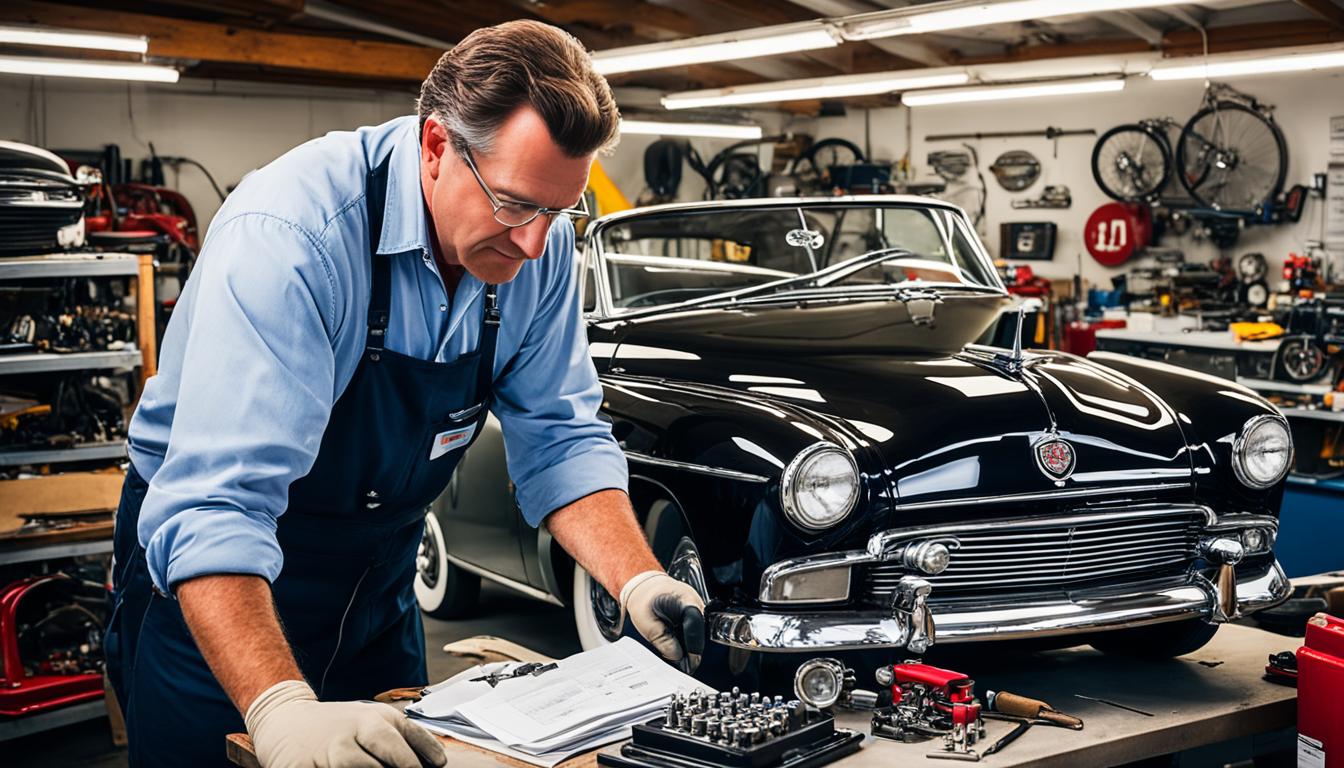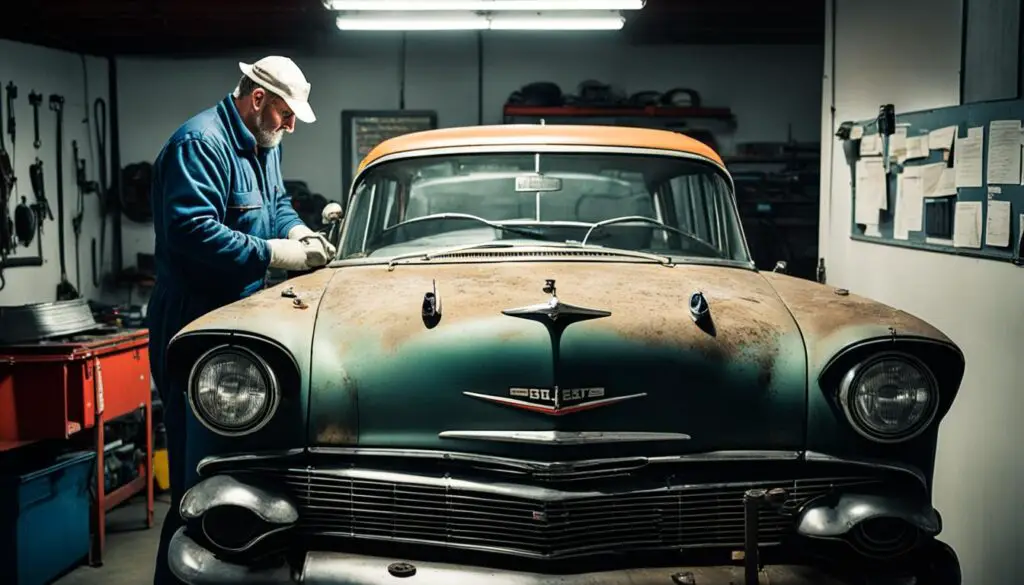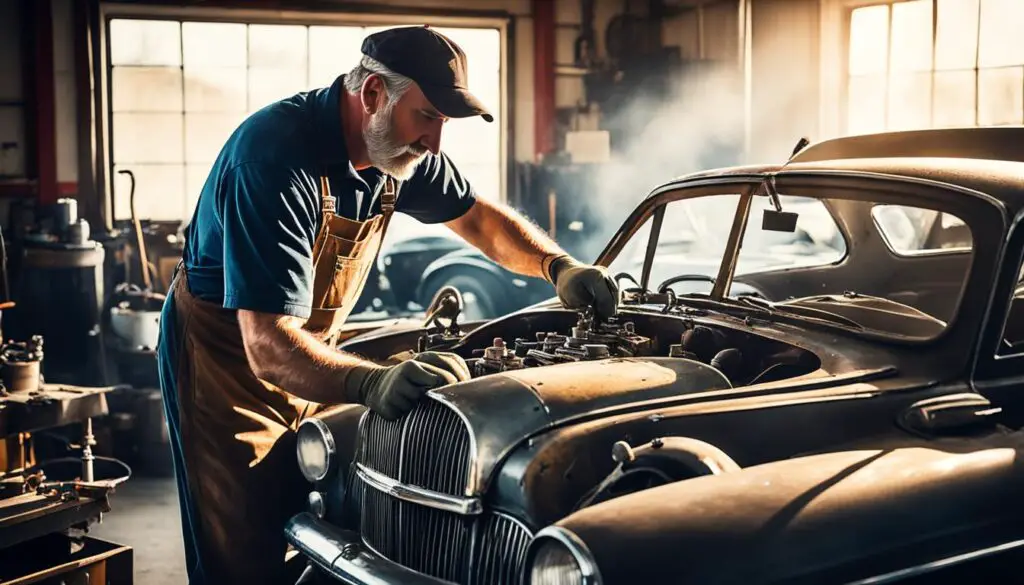
Budgeting Beauty: Classic Car Restoration Cost Guide
Restoring a vintage beauty is thrilling. Yet, careful budgeting is vital to avoid overspending. This guide offers tips to manage your finances wisely during a classic car restoration.
It’s more than just spending money. It’s saving history and honoring cars’ past. Whether you love old cars or want to make a profit, setting a smart budget is key.
Understanding the costs and using wise budgeting can make your project affordable. Quality won’t suffer. Let’s look at tips for a successful and budget-friendly restoration.
Key Takeaways:
- Evaluate your restoration goals and budget realistically.
- Thoroughly research classic car restoration costs and market trends.
- Consider DIY options and professional assistance.
- Prioritize necessary repairs and modifications.
- Properly maintain a detailed budget throughout the restoration process.
These tips let you start a classic car restoration with confidence. It’s more than managing costs. It’s a journey of history and craftsmanship appreciation.
Assessing Your Classic Car: The First Step to Restoration Success.
Before you start restoring your classic car, figure out its condition. This is the first step to planning and budgeting your project. Knowing your car’s state will guide your choices and help you set achievable goals.
1. Research Specifications
Begin by finding out the original specs of your car. You need to know the exact look and features your car had when it was new. Look for manuals or brochures that tell you about its make, model, and year.
2. Evaluate the Vintage Vehicle Condition
Thoroughly check over your car to see what shape it’s in. Look for things like wear, damage, rust, or areas that need quick fixes. Make a list of these problems and decide how much work is needed.
Take notes on the condition of the body, inside, engine, and other important parts. This lets you plan what to fix first and how much time and money each part will need.
3. Set Restoration Goals
After checking your car, decide on your restoration goals. Think about how much you want to restore it to its original state or if you want to customize it. Setting clear goals helps you focus your work and money wisely.
4. Establish a Budget
Now it’s time to create a budget based on your assessment and goals. Think about the cost of parts, labor, and any extra services you might need. Make sure your budget aligns with your goals. Being realistic about what you can spend is key.
With these steps done, you’re ready for a successful restoration project. A clear plan means you can move forward with confidence. You’re on your way to reviving your classic car.

| Component | Condition | Notes |
|---|---|---|
| Body | ||
| Interior | ||
| Engine | ||
| Suspension | ||
| Electrical Systems |
The Restoration Process: A Step-by-Step Journey Through Time.
Once you’ve set your goals for the classic car, it’s time to start restoring. This journey will make your vintage car shine. We’ll look at the important steps in the restoration process next.
1. Disassembly
First, the car gets taken apart. You carefully remove all parts like body panels, interior, and more. This inspection helps find what needs fixing or replacing.
2. Bodywork
Next up is fixing the car’s body. You’ll repair rust, dents, and other damages. This includes sanding, filling spots, and painting. Bodywork makes the car look perfect again.
3. Engine Restoration
The engine’s the car’s heart, needing special attention. Repair or rebuild it for top performance. This means changing old parts and tuning for power. Thorough and detailed work here keeps the car true to its history.
4. Assembly
Now, it’s reassembly time. Put everything back together. This includes body, interior, and mechanical parts. Doing this carefully, the car starts looking and working as it should.
Keep things organized through the whole process. Follow your plan closely and track everything. This way, the restoration won’t hit any bumps.
We’ve covered the beginning phases of restoring your car. Next, we’ll dive into the final steps. Then, we’ll celebrate your car’s full restoration.

In Conclusion: Preserving History Through Classic Car Restoration.
Looking back at my classic car restoration, I see its importance in saving car history. Restoring a vintage car honors its past glory and creativity. Each restoration step showed my love for the final result.
I came to understand classic car detail and history during this journey. By fixing up these vintage rides, I praise the work of old inventors. Their design and hard work deserve respect.
The joy of finishing a classic car project is more than its beauty. It’s about spreading the story and passion behind it. These cars bring the past alive, encouraging car fans of all ages. They’re stars at events, on roads, or in private places, showing we care about yesterday and tomorrow.
FAQ
How much does classic car restoration cost?
The cost to restore a classic car varies. It depends on the car’s condition, the work needed, and the quality of parts. Setting a budget and getting professional advice is wise for an accurate cost estimate.
How long does classic car restoration take?
Restoring a classic car’s timeline varies on its needs and part availability. Discussing with experts or enthusiasts gives you a clearer idea of the time involved.
Can I minimize classic car restoration costs?
There are ways to save on restoration costs. Doing some work yourself and finding cheap parts help. Also, looking for a partly restored car can cut down on work and cost.
Should I restore a classic car as an investment?
Restoring a classic car can raise its value, but it’s not always a guaranteed investment. The main reason to restore should be for love and history. Yet if investing, extensive research and advice are key.
Can I enjoy a restored classic car as a daily driver?
Driving a restored classic car daily is doable, but keep some things in mind. They may not offer modern performance or safety. Good upkeep and maintenance are crucial for their operation.
Where can I find professional classic car restoration services?
To locate top restoration experts, start by looking into local shops or classic car specialists. Online searches, forums, and word-of-mouth can also point you to trusted professionals.
How can I ensure the authenticity of a restored classic car?
To make sure a classic car is truly restored, detailed research and care are essential. Using original parts and adhering to factory specs helps. Collaboration with experts ensures the car’s authenticity.
